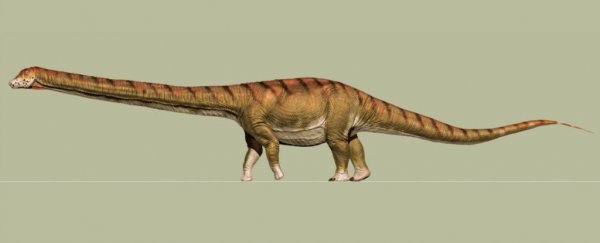Weighing nearly 70 US tons (63 tonnes), heavier than 10 adult African elephants, this dinosaur was the largest animal to ever walk on Earth, according to some scientists.
This plant-eating beast first made headlines in 2014, after a rancher from Patagonia in Argentina discovered a fossil bone. Last year, the American Museum of Natural History in New York added a cast of the 122-foot-long (37-metre-long) dinosaur to its exhibit.
Its neck and head are so long that they extend outside the gallery.
Despite its fame, the dinosaur did not have an official scientific name - until now.
A report published Wednesday in the journal Proceedings of the Royal Society B. calls it Patagotitan mayorum.
"Patagotitan" can be interpreted as "giant from Patagonia," and "mayorum" is a tribute to the rancher family that hosted a team of paleontologists, geologists, students and volunteers as they excavated dozens of fossils from the area.
Have you met the Patagotitan? Dinosaur, the Argentine way! https://t.co/x177iyYYEg #patagonia #Argentina #titanosaur #patagotitan pic.twitter.com/2Gfpbc7sp8
— Consulado General Argentino en Nueva York (@ARGenNewYork) August 9, 2017
More than 150 Patagotitan fossils have been unearthed there over the past few years. Finding a significant number of fossils belonging to the same species is not rare, dinosaur specialist José Luis Carballido told The Washington Post in an email. But for such a big animal, it is.
"It's a real paleontological treasure," Carballido said, according to the museum's website.
"There were lots of fossils in great preservation, practically intact, something that does not happen often."
These discoveries have allowed scientists to create the most complete anatomic reconstruction of any large terrestrial herbivore in the planet's history, according to the Egidio Feruglio Paleontology Museum in Trelew in Argentina's Chubut province.
Patagotitan, which lived about 100 million years ago during the late Cretaceous Period, is considered a titanosaur, a diverse lineage of plant-eating, long-necked dinosaurs with long tails that walked on four legs.
Titanosaurs varied greatly in size, with the smallest species weighing as much as an adult elephant and the largest ones weighing more than 60 US tons (55 tonnes).
The discovery of Patagotitangave scientists a clearer picture of how titanosaurs evolved in terms of their body mass. The study revealed that most of the giant titanosaurs discovered in Patagonia belonged to a single lineage, according to the museum.
"This means that the evolution of extreme gigantism within titanosaurs happened but only once, and not in multiple separate events," Diego Pol, one of the authors of the study, said in a statement.
"We can see some other cases of size increase relative to the ancestral size of titanosaurs, but none of them was as dramatic as the one seen in this group and exemplified by Patagotitan."
Patagotitan's most important contribution to science, Carballido said, is the amount of information it gave to researchers.
Scientists have found fossils of other giant dinosaurs in the titanosaur lineage such as Argentinosaurus and Puertasaurus in the Argentine desert.
But unlike Patagotitan, scientists had to rely on a limited number of bones to get a sense of their weight and size, Carballido said.
But with the Patagotitan, scientists were able to find its humerus (arm bone) and femur (thigh bone), which were not discovered for Agentinosaurus or Puertasaurus, Carballido said.
Some, however, are cautious about proclaiming Patagotitan the biggest of them all.
Mathew Wedel, a paleontologist at the Western University of Health Sciences in California, told Smithsonian Magazine that it's more likely that Patagotitan is not bigger but comparable in size to Argentinosaurus, the previous record holder.
"I think it would be more accurate to say that Argentinosaurus, Puertasaurus and Patagotitan are so similar in size that it is impossible for now to say which one was the largest," Wedel said.
2017 © The Washington Post
This article was originally published by The Washington Post.

